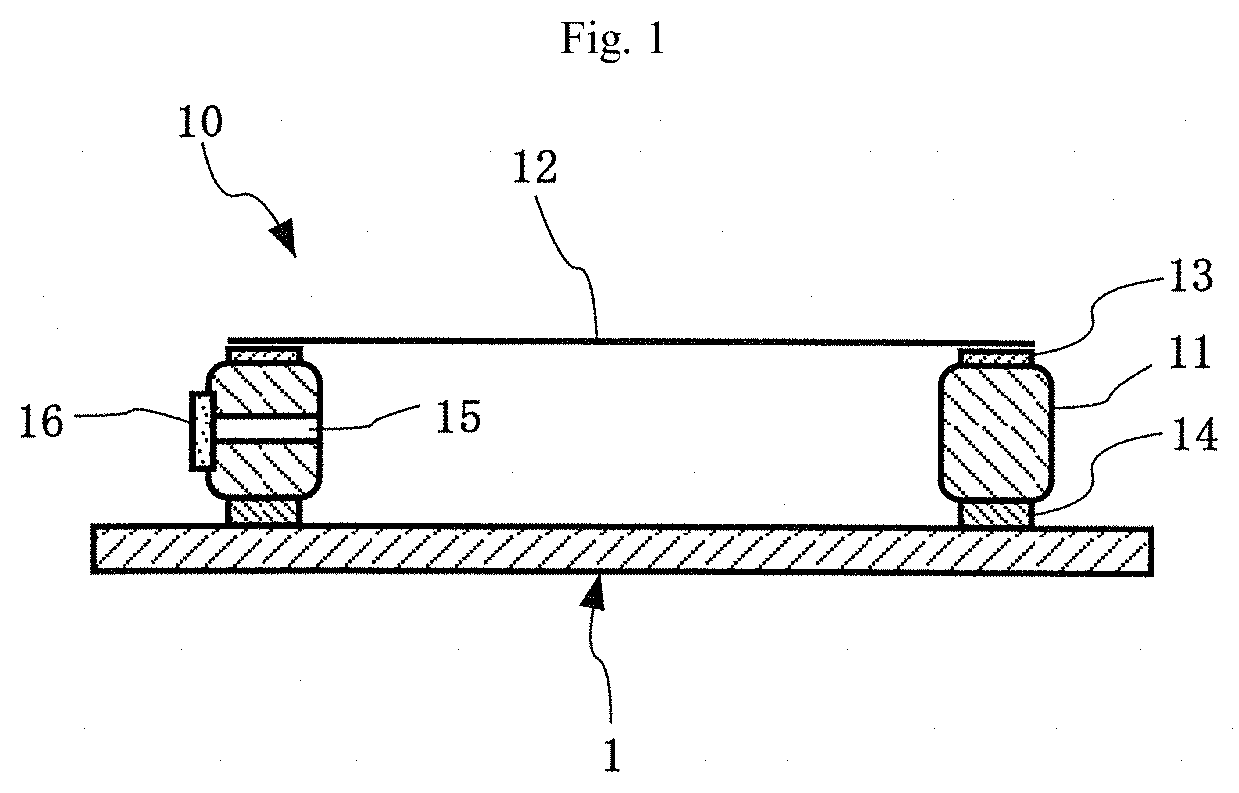Agglutinant for Pellicles, Pellicle Frame with Agglutinant Layer, Pellicle, Exposure Original Plate with Pellicle, Exposure Method, Method for Producing Semiconductor, and Method for Producing Liquid Crystal Display Board
a technology of pellicle and agglutinant layer, which is applied in the direction of originals for photomechanical treatment, adhesive types, instruments, etc., can solve the problems of chemical reconsideration, phase shift film is very delicate, corrosion and scraping, etc., and achieves the effect of reducing peeling residue, reducing damage to the exposure original plate surface during cleaning, and loosing cleaning conditions
- Summary
- Abstract
- Description
- Claims
- Application Information
AI Technical Summary
Benefits of technology
Problems solved by technology
Method used
Image
Examples
example 1
[0091]After a pellicle frame (external size: 149 mm×115 mm×3.5 mm, thickness: 2 mm, flatness of an end face coated with a mask bonding agglutinant: 15 um) made of an aluminum alloy was subjected to precision cleaning, an acrylic agglutinant manufactured by Soken Chemical Co., Ltd. (product name: SK-Dyne SN-25B, an agglutinant containing, as a base material, an acrylic polymer containing an ethylene oxide group-containing (meth)acrylate and butyl acrylate as monomer components, in which about 40 mass % of the monomer components was the ethylene oxide group-containing (meth)acrylate, and about 40 mass % of the monomer components was the butyl acrylate) was applied to the end face with a flatness of 15 um, and allowed to stand for 60 minutes at room temperature. Thereafter, a separator was placed on an aluminum plate with a flatness of 5 um, and the pellicle frame coated with the agglutinant was placed so that the agglutinant faced down. Thus, the agglutinant was brought into contact w...
synthesis example 1
[0104]A 5-L flask equipped with a stirrer, a reflux condenser, a thermometer, and a gas inlet was charged with 350 g of butyl acrylate, 550 g of 2-methoxyethyl acrylate, 40 g of acrylic acid, 25 g of 2-hydroxyethyl acrylate, 1400 g of ethyl acetate, and 2 g of azobisisobutyronitrile as a polymerization initiator. Solution polymerization was carried out at 68° C. for 8 hours in a nitrogen gas stream. After the completion of the reaction, 830 g of ethyl acetate was added thereto, thereby obtaining a solution of an acrylic polymer with a solid content of 30%. A polyisocyanate solution was added to the obtained acrylic polymer solution, and the mixture was stirred and mixed to obtain an agglutinant.
synthesis example 2
[0105]A 5-L flask equipped with a stirrer, a reflux condenser, a thermometer, and a gas inlet was charged with 360 g of propyl acrylate, 500 g of 2-ethoxyethyl acrylate, 50 g of acrylic acid, 1300 g of ethyl acetate, and 2 g of azobisisobutyronitrile as a polymerization initiator. Solution polymerization was carried out at 68° C. for 8 hours in a nitrogen gas stream. After the completion of the reaction, 1130 g of ethyl acetate was added thereto, thereby obtaining a solution of an acrylic polymer with a solid content of 30%. A polyisocyanate solution was added to the obtained acrylic polymer solution, and the mixture was stirred and mixed to obtain an agglutinant.
PUM
| Property | Measurement | Unit |
|---|---|---|
| flatness | aaaaa | aaaaa |
| thickness | aaaaa | aaaaa |
| size | aaaaa | aaaaa |
Abstract
Description
Claims
Application Information
 Login to View More
Login to View More - R&D
- Intellectual Property
- Life Sciences
- Materials
- Tech Scout
- Unparalleled Data Quality
- Higher Quality Content
- 60% Fewer Hallucinations
Browse by: Latest US Patents, China's latest patents, Technical Efficacy Thesaurus, Application Domain, Technology Topic, Popular Technical Reports.
© 2025 PatSnap. All rights reserved.Legal|Privacy policy|Modern Slavery Act Transparency Statement|Sitemap|About US| Contact US: help@patsnap.com

